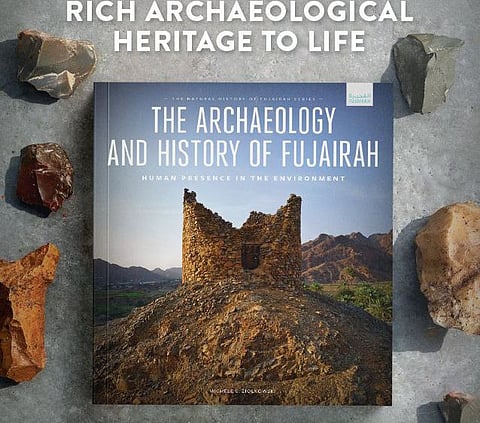New book traces Fujairah’s history to the Paleolithic era
Autrhor explores emirate’s rich and varied archaeological heritage

Fujairah: Do you know of a place called Jebel Kaf Addor in Fujairah? Well, it is a Paleolethic site that played a strategic role during the movement of early humans from Africa to the Arabian Peninsula.
Fascinating details about Jebel Kaf Addor have been revealed for the first time in the second of the series of books on the natural history of Fujairah. Titled The Archaeology and History of Fujairah, the book has just been launched by the Fujairah Tourism and Antiquities Department under the patronage of Sheikh Mohammed bin Hamad bin Mohammed Al Sharqi, Crown Prince of Fujairah.
Initiated by the Fujairah Environment Authority, The Archaeology and History of Fujairah and authored by Dr Michele Ziolkowski, the book traces the chronology of Fujairah from the Paleolithic to the mid-twentieth century, examining Fujairah’s varied archaeology over the ages.
The book, rich with photographs, drawings and maps, illuminates how the ancient population lived and flourished by working with the local environment. It covers topics ranging from stone tools to burial cairns, and fortifications to villages and rock art, offering a wealth of information to students, archaeologists, or anyone interested in the history of Fujairah.
The book is the culmination of extensive environmental research projects and archaeological and historical research initiatives spearheaded by Sheikh Mohammed. It also reflects his dedication and commitment to the book series and the broader environmental initiatives of the Government of Fujairah. The book also features a forward by the Crown Prince, in which he underlines that as more evidence comes to light from the Paleolithic and Neolithic periods, we can piece together Fujairah’s important role in the movement of early humans from Africa into the Arabian Peninsula. He points out that by combining climate and environmental data with archaeological artefacts and sites, this book weaves the various interconnecting threads into a concise account of Fujairah’s history.
Dr Ziolkowski says: “Fujairah has a rich and varied archaeological heritage, which is deeply connected with the natural environment. Since I first visited Fujairah in 1993 as an undergraduate archaeology student, I have been drawn to the beauty of mountains and wadis and intrigued by the historical sites, especially Fujairah Fort and village, which seemed to capture a moment in time. I am grateful to Sheikh Mohammed bin Hamad Al Sharqi, Crown Prince of Fujairah, for the opportunity to write this timely book on the archaeology and history of Fujairah. It was indeed an honour to be asked to research and write a book on Fujairah, a place I have come to call home.”
Peer-reviewed by academics, the book is divided into 12 chapters which discuss the History of Archaeological Research in Fujairah; the peopling of the Arabian Peninsula (Palaeolithic and Neolithic); the Hafit period (end of the fourth millennium BC to the beginning of the third millennium BC): The Umm an-Nar period (circa 2500–2000 BC); The Wadi Suq period and the Late Bronze Age (2000–1600 BC) and (1600–1300/1250 BC); the Iron Age (1300/1250–300 BC); the late pre-Islamic period (300 BC–seventh century AD); the eve of Islam (seventh century AD); Tenth to fifteenth centuries AD; the Portuguese presence in Fujairah and the East Coast; the late Islamic period (17-18th to 20th centuries AD) and the rock art of Fujairah.
In addition, the book also features a special section encompassing the contributions of Dr Lloyd Weeks on the evidence for ancient copper mining and smelting in Fujairah.
Saeed Al Samahi, Director General of the Tourism & Antiquities Department, Fujairah, says: “The Archaeology and History of Fujairah, the second book in the Natural History of Fujairah series, is a comprehensive examination of the Emirates’ rich archaeological heritage. We are delighted to play a key role in launching the book that links Fujairah’s past and future and presents material evidence of Fujairah’s varied archaeological heritage. The wealth of information on Fujairah’s history that the book offers will be a significant addition to the archaeological research in the nation.”
Sign up for the Daily Briefing
Get the latest news and updates straight to your inbox


